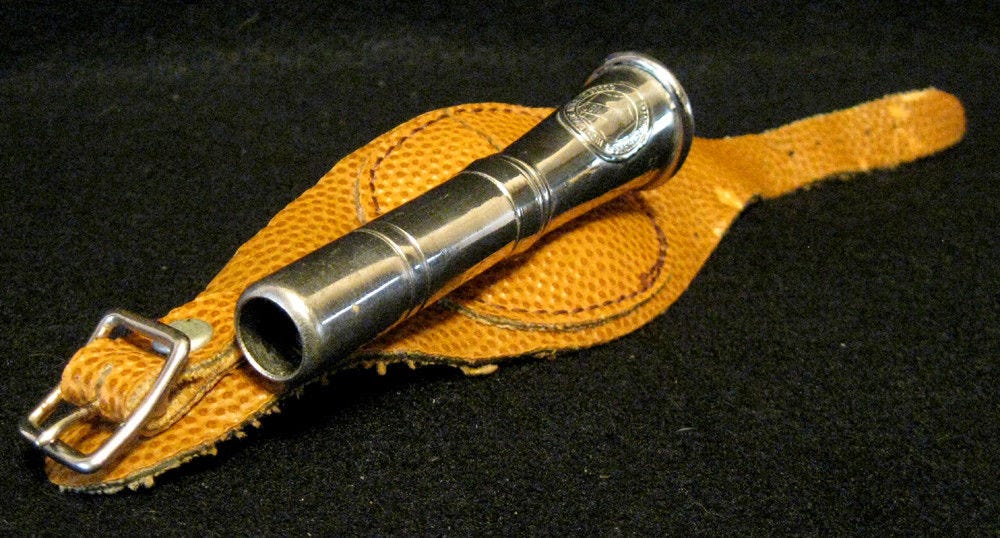When Football Officials Tooted on the Field
Officials have whistled football plays dead for many years, but whistles were not used when the game of football began, largely because whistles as we know them did not yet exist. Low volume whistles go back to ancient times, but they could only be heard at limited distances. That changed in the early 1880s when England’s Scotland Yard published a request for a noise-making device to replace the hand rattles policemen used to call for support. The request led Joseph Hudson to invent the first effective pea whistle which could be heard a mile away. Scotland Yard adopted Hudson’s Acme whistle in 1883 and the whistles quickly saw use in soccer and rugby matches. American football adopted whistles in 1887 to signal fouls and to stop plays. (Before then, the tackled player yelled "Down" to stop play.)
The problem, of course, was that officials blew their whistles both to stop play and to signal fouls which were not supposed to stop play. Confusion ensued with players on defense sometimes hearing a whistle and stopping play, while the offensive players played on, scored touchdowns, and then declined the penalty on the defense.
This continued for seventeen years until 1904 when new rules called for the referee, whose job was to monitor the progress of the ball, to use the whistle to call the play dead. The umpire, meanwhile, went whistle-less and used a bell or horn to signal penalties. Unlike the whistle that stopped play, the umpire’s signal meant play should continue.
The use of bells by umpires never caught on, but horns did. Period photographs show some umpires holding bulbed horns similar to those on bicycles. Most umpires wore small horns that worked and sounded like a kazoo on wristwatch-like straps. Despite the difference in sound between the whistle’s tweet and the horn’s toot, some players kept hesitating or stopping play when they heard the horns.
Another sound maker entered the fray in 1924 when the timekeeper began using a starter’s pistols to signal the end of each quarter. Though it added another audible signal, the pistol was used only after the last play of a quarter was declared dead, so it did not interfere with play. The pistol became redundant when scoreboards with running clocks became universal and the pistols were dropped from use.
A Sound Alternative
One plan to resolve the toot-tweet problem came from H. L. Williams, Minnesota’s Hall of Fame coach. He suggested a flag-based system in 1917 to both signal penalties as they occurred and to communicate the nature of the penalties to the spectators after the play. His system was a combination of the flags used by soccer referees as well as the military semaphore systems of the time, but it is unclear whether Williams’ flag system was ever used in a game.
The idea of using dropped or thrown flags to signal penalties popped up a few decades later. One former high school official from Pennsylvania claimed he used a penalty flag starting in 1935 because he had been accused of showing preferences by supposedly calling penalties after plays ended. Throwing the flag in the midst of the play mitigated that problem. Penalty flags were also in use in Florida by 1940 since a newspaper columnist editorialized about how frequently officials dropped their handkerchiefs in a high school game and in the Florida-Tampa college game played on the same weekend.
The thrown flag landed on the national scene due to Dwight ”Dike” Beede, Youngstown State’s longtime coach. Like others, Beede wanted to remove the confusion between horns and whistles, so he asked his wife to sew a handful of small, weighted flags. Using red fabric from an old Halloween costume, white fabric from a bedsheet, and drapery weights, the Betsy Ross of football created a set of striped penalty flags. Beede convinced the opposing coach and the officiating crew to use the flags in Youngstown State’s game with Oklahoma City University in 1941.
Everyone seemed to like the flags, including one of the game officials, Jack McPhee, who kept his flag and continued using it. McPhee was a Big Ten official and used the flag in prominent games, including the 1948 Rose Bowl, and the thrown flag caught on in grass roots fashion.
Penalty flags were officially adopted by the colleges in 1948 and most of the confusion over penalties has disappeared since then. Some confusion continues because the thrown flag does not differentiate between offensive and defensive penalties. The rule makers of 1948 recommended that officials drop the flag toward the offending team’s bench, while later rule makers considered, but did not adopt, a proposal to use flags of different colors for offensive and defensive penalties.
Perhaps the lack of differentiation is a good thing. All of us have seen plays with flags thrown on plays in which the foul was clearly committed by the offense or the defense. There are also many plays in which the teams and crowd are uncertain of which team committed the foul. That confusion brings drama to the game as evidenced by the groans and loud cheers that follow the referee’s announcement of which team committed the foul.
Of course, the advent of video replay has changed that dynamic as well. The officials may no longer toot on the field, but they’ll likely toss the field laundry for years to come.
Football Archaeology is reader-supported. Click here to buy one of my books or otherwise support the site.



